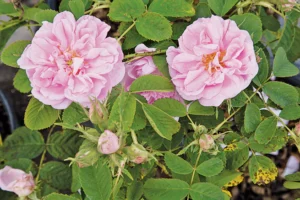
I love the smell of roses so very much that I hardly expect anything of rose essential oil than to simply smell like a rose.
Only today, I decided to see if rose essential oil also has healing qualities, and I was delighted:
Rose essential oil has many potential health benefits, including:
- Skin care: Rose oil can help with acne, wrinkles, and dandruff. It can also soothe the skin and scalp, and nourish hair follicles.
- Anti-inflammatory: Rose oil has antiseptic, bactericidal, and anti-inflammatory properties, which can help with eczema and allergic rashes.
- Wound healing: Rose oil has been used as a cicatrisant (wound-healing) ingredient for a long time.
- Stress and anxiety relief: The scent of rose oil can have a calming effect on the mind and body, helping to reduce stress and anxiety.
- Pain relief: Rose oil may help reduce pain.
- Arthritis management: Rose has anti-arthritic, anti-inflammatory, and analgesic activity.
- Mood elevation: Rose oil may help elevate mood.
- Blood circulation: Rose oil can help improve blood circulation.
Rose oil can be used topically or inhaled. Google ai
Antibacterial, antifungal properties
“Researchers have found that essential oil distilled from roses can be effective against a wide range of microbes that cause infections. This includes E. coli, as well as some strains of the bacteria that can cause staph infections (Staphylococcus) and strep throat (Streptococcus).
“Additionally, the study found that rose oil was effective against Candida albicans, which can cause fungal infections in the mouth, gut, and vagina.” Healthline
How to use rose oil
“Rose oil is usually quite expensive and is highly potent. It should be diluted whether you plan to inhale it or use it on your skin.
- To make a rose oil bath, add 10 drops of rose essential oil to a carrier oil, then add to a warm tub. Essential oils should always be diluted in a carrier oil before adding to water.
- To make a foot bath, add a few drops of diluted rose oil into the foot bath and soak your feet for 10 minutes.
- To treat anxiety, stress, or depression, you can either inhale rose oil using a diffuser or dab it lightly on your chest, neck, and wrists. Be sure to blend it with a carrier oil first like coconut, almond, or jojoba oil before it touches the skin. You may also benefit from a rose oil massage, in which the rose essential oil is added to a carrier massage oil. Healthline
Tips for buying rose oil
“You can find rose essential oil in natural food stores or shop for rose oil online.
“The two most common rose oils are distilled from the R. damascena, which has a higher oil content, and R. centifolia varieties. Experts at the University of Minnesota recommend that you check the label for the Latin name of the plant and the country of origin so you can get a good idea of the source.”
Autumn Damask
Image Credit: Antique Rose Emporium
Prior to 1819
4 to 5 feet
“This is quite probably the plant that writers in antiquity described as the Four Seasons Rose of Paestum. ‘Autumn Damask’ is the only one of the Old European roses to repeat its bloom, and some rosarians have suggested that it is a species hybrid with R. chinensis, created where the far edges of their ranges touch. Its garden value is undeniable, with richly fragrant flowers occurring in abundance on a compact, hardy shrub in spring, followed by scattered blossoms through the summer and fall. Light pink and double, this ruffled rose contains a good measure of Damask scent, possibly the finest perfume in the rose world.” Antique Rose Emporium

Marhessa Boccella
Image Credit: Antique Rose Emporium
1842
3 to 5 feet
“A mild confusion surrounds this rose since it is apparently the same plant that was also sold much later under the name ‘Jacques Cartier’. ‘Marchessa Boccella’ is in constant bloom for us, one of the few members of the class to justify the “perpetual” in its name. The delicate pink flowers are flat, petal-crowded confections that sit in clusters of three atop healthy, jade green foliage. Its heavy damask scent is why we always recommend this rose for fragrance gardens.”
 Rose de Rescht
Rose de Rescht
Image Credit: Antique Rose Emporium
Prior to 1900’s
3 to 5 feet
“‘Rose de Rescht’ is exquisitely fragrant and can easily fill a garden with it’s perfume. It is best suited as a loosely cascading or rounded shrub to five feet. Companion plantings of blue and white perennials accent this rose’s lilac pink flowers well. It has an extended spring bloom. One of the best virtues of this rose, unlike many of the other cold loving Damasks, is its ability of thrive in the warmer Southern gardens. It is believed to have gotten its name from the Persian city of Rescht.” Antique Rose Emporium

Russelliania
Prior to 1837
6 to 12 feet
Gifted with many names because of its continued popularity (“Russells Cottage”, “Scarlet Grevillea”, “Old Spanish Rose”, “Souvenir de la Bataille de Marengo”) this hybrid of R. multiflora is in a class by itself. The very double, medium-size flowers of crimson mauve fading to lilac cover the bush in color each Spring. The scent is Damask, and the foliage is quite distinct- large, rich blue-green, deeply veined, and unmistakable. ‘Russelliana’ has been grown as a shrub, a climber, and as a pillar rose.
Discover more from Jacki Kellum
Subscribe to get the latest posts sent to your email.